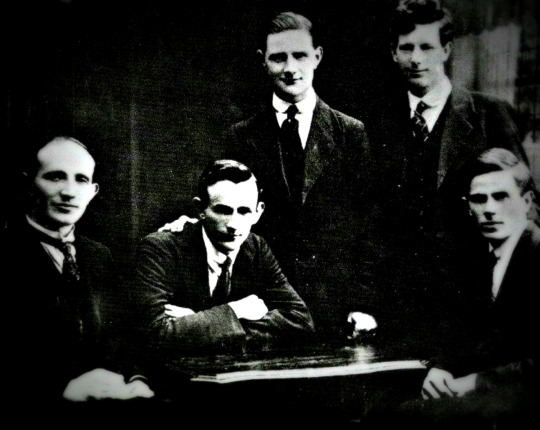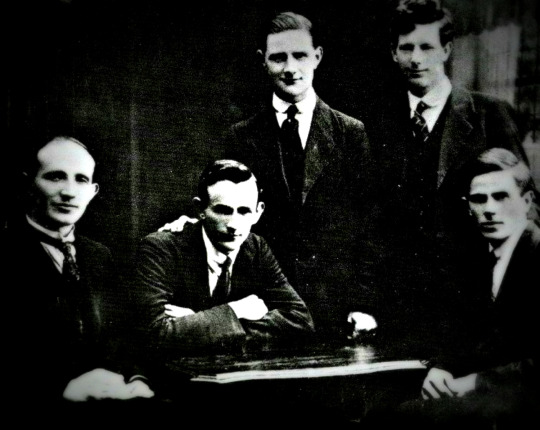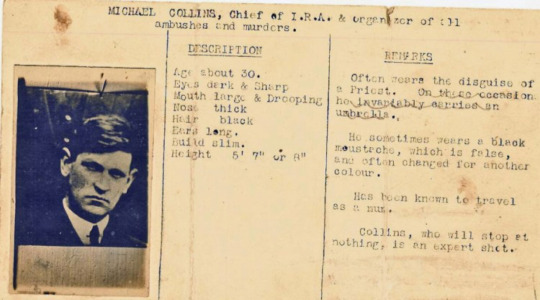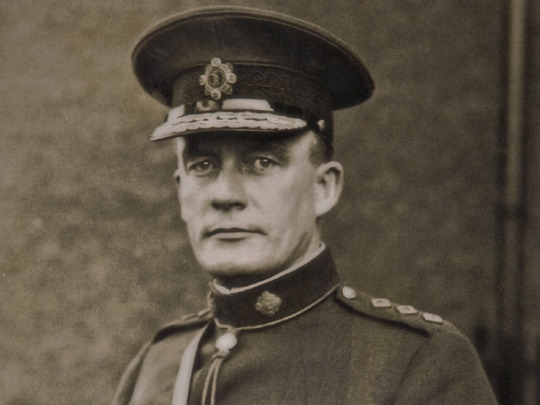#Ned Broy
Text




Michael Collins (1996)
8 notes
·
View notes
Text
#OTD in 1919 – The first assassination authorised by Michael Collins – Detective Sergeant the Dog Smyth was shot by The Squad.
“Our only way to carry on the fight was by organised and bold guerilla warfare. But this in itself was not enough. England could always reinforce her army. To paralyse the British machine it was necessary to strike at individuals outside the ranks of the military. Without her Secret Service working at the top of its efficiency England was helpless; robbed of the network of this organisation…

View On WordPress
#&039;G&039; Division#46 Rutland Square#Cairo Gang#Cathal Brugha Barracks#Criminal Investigation Department#Croke Park#Dáil Eireann#Detective Sergeant &039;The Dog&039; Smith#DMP#Drumcondra#Dublin Brigade#Dublin Castle#England#Harcourt St#IRA#Irish Civil War#Irish War of Independence#Michael Collins#Ned Broy#Rathmines#RIC#Sergeant Daniel Hoey#Sinn Fein#The Squad#Twelve Apostles#William C. Forbes
6 notes
·
View notes
Text
And Ned Broy enters the scene!
For anyone watching Andor and thinking they sense a connection with Irish history...you are so right in so so so many ways. I have got to write up a list of more of these.
But the treaty of 1922, that led to both the Irish Republic and the current state of partition? That came out of a guerrilla war, a spy war fought by the agents of the Squad, an elite unit organized by Michael Collins at the one of the most unified and powerful moments in Irish history. Michael Collins has been modeled and paraphrased multiple times by Luthen.
In the most recent episode, we met an ISB informant come to warn the budding rebellion of a raid planned that will wipe out rebel forces. And Luthen, like many Irish leaders when Ned Broy first approached as a defector from the British intelligence network running out of Dublin, lets the raid go forward to keep the cover of their source, test their source, and build the informant network that crumbled the Castle headquarters and its hold over the Irish people.
Watching this show right when I'm researching so much of the history from which they took inspiration is such a gift. This is just masterfully crafted--knowing the history they're echoing is just making this all the more intense. Guh I'm so fucking stoked there's two more episodes to explore the flame this spark is about to ignite.
#andor#yes im a fucking nerd for#irish history#the troubles#star wars#historical parallels#so well done#spy fi#at its finest
16 notes
·
View notes
Text
i trust that most people here know the beef i have with the michael collins movie. that being said, that really short scene with ned broy in the library gives me so much joy. just. everything about it. how mick sort of sneaks up behind broy. the height difference. the people off in the corner giving them Looks. the part when mick says, "anything is possible if you believe hard enough" and broy's like, is that some sort of republican slogan, and mick just holds up peter pan by j.m. barrie and goes "no, 'twas him! peter pan! :D" and leaves broy looking so confused
#michael collins movie#michael collins#ned broy#irish history#world history#european history#history
6 notes
·
View notes
Note
To flip around the insurgency question-why were the Irish so successful? What do insurgent movements in the past century owe to them?-TBH
The Irish insurgency owes its success to a number of factors.
Timing is one of them, the English had been fighting in the First World War and were a shattered army with poor morale. The idea of ethnic self-determination was big in the post-WWI treaties, even if it was really only selectively applied. The Irish may not have gotten much face-time with Woodrow Wilson or support for an independent Ireland, but the climate for Irish independence was very strong.
David Galula stresses in counter-insurgency tactics that the goal is to gain the support of the population. Heavy-handed reprisal policies against the Irish such as those performed by the Black-and-Tans and the fear of conscription into the British Armed Forces created a climate of hostility to the British and secured local support to the Irish nationalists. Brutal crackdowns like house burnings also made an effect in the foreign press, with other nations protesting British actions, even Weimar Germany had been critical of their conduct.
Information supremacy was another big thing. With Ned Broy being able to infiltrate the G-Division of the Dublin police, the IRA was able to effectively eliminate the ability for the informants to attack insurgents and eliminate the ability for the British to provide security for their own informants, reducing the population’s ability to cooperate with them.
Endurance however, was one of the primary virtues and cause for success. The IRA was badly hurting for ammunition and materiel, but had been able to keep the war going for David Lloyd George to face severe political opposition. The Truce was sorely needed by Ireland, who were able to recruit and secure more weapons and ammunition from friendly sources to be smuggled into the country. Successful insurgent campaigns need to be able to maintain themselves for the larger, more powerful side to consider a peace deal. That doesn’t just mean sustaining the fight, but keeping the forces united. Plenty of insurgencies fall apart because partisan groups fight amongst each other hoping to be in the strongest possible position.
Thanks for the question, Anon.
SomethingLikeALawyer, Hand of the King
36 notes
·
View notes
Photo

365 Day Movie Challenge (2017) - #106: Michael Collins (1996) - dir. Neil Jordan
Michael Collins is easily the second weakest of the seven Neil Jordan films that I have seen (nothing could ever top the awfulness of one of Jordan’s earliest American features, We’re No Angels). As a biopic/period piece, Michael Collins gets the job done, but Jordan’s forte is smaller-scale, more intimate dramas/comedies: Angel, Mona Lisa, The Crying Game, Breakfast on Pluto. (Even another Hollywood production, Interview with the Vampire, is successful because of its no-holds-barred intensity.) I liked Michael Collins’ cinematography, though, which was filmed by Chris Menges; it’s heavy on the use of blue, just like Jordan and Menges’ previous collaboration on Angel. The heavily saturated look is an intriguing aesthetic, making the events of Michael Collins all the more melancholy.
Prior to watching the film, I didn’t know anything about the history of Michael Collins (portrayed movingly by Liam Neeson) or his importance in Ireland’s ability to secure independence from the UK’s invasive rule. The film begins with the Easter Rising in 1916, an armed insurrection which Neil Jordan depicts as one of the first important events for Michael Collins as a leading figure in the rebellion. Jordan shows Collins’ friendships with Harry Boland (Aidan Quinn), a fellow politician, and Éamon de Valera (Alan Rickman), who later served as President of Ireland from 1959 to 1973. We see Collins’ interactions with numerous other political associates and opponents, including Ned Broy (Stephen Rea), Joe O’Reilly (Ian Hart), Liam Tobin (Brendan Gleeson), a villainous MI-5 officer named Soames (Charles Dance) and a young man whom Collins meets in a bar at the end of the film (Jonathan Rhys Meyers), but a large portion of the dramatic weight also comes from Collins’ romance with Kitty Kiernan (Julia Roberts, whose performance is actually quite likeable despite her terrible attempt at an Irish accent), a local woman who first dated Harry Boland.
The violence of Michael Collins shows the bloody lengths that the Irish Republican Army went to in order to liberate their country from the shackles of the British government. In spite of the film’s excessive running time (133 minutes), the film is pretty well-paced, especially in its tense scenes of chases and/or battles. My favorite part of the film, though, is the sequence of scenes that cut back and forth between a love scene with Mick (as he is affectionately called by his nearest and dearest) and Kitty and a series of executions carried out by that Mick’s cohorts. It reaffirms Jordan’s strength as a filmmaker: the aforementioned penchant for stories revolving around the powers of intimacy, sensuality and uncertain futures.
#365 day movie challenge 2017#michael collins#1996#1990s#90s#neil jordan#chris menges#liam neeson#harry boland#aidan quinn#éamon de valera#eamon de valera#alan rickman#ned broy#stephen rea#ian hart#brendan gleeson#charles dance#jonathan rhys meyers#kitty kiernan#julia roberts
0 notes
Text
#OTD in 1972 – Éamon ‘Ned’ Broy, agent for Michael Collins, and later Commissioner of the Garda Síochána, passed away.
During the Irish War of Independence, Ned Broy was a double agent within the Dublin Metropolitan Police (DMP), with the rank of Detective Sergeant. He worked as a clerk inside G Division, the intelligence branch of the DMP. While there he copied sensitive files for Michael Collins. On 7 April 1919, Broy smuggled Collins into G Division’s archives in Great Brunswick Street (now Pearse Street),…

View On WordPress
#&039;G&039; Division#An Garda Síochána#Éamon De Valera#Co. Kildare#Coolegagen cemetery#Cumann na nGaedheal#Dublin#Dublin Metropolitan Police#Fianna Fáil#Great Brunswick Street#Ireland#Irish Civil War#Irish War of Independence#Michael Collins#Ned Broy#Pearse Street#Rathangan#Seán Nunan#Stephen Rea
6 notes
·
View notes
Text
#OTD in 1919 – The first assassination authorised by Michael Collins – Detective Sergeant the Dog Smith was shot by The Squad.
#OTD in 1919 – The first assassination authorised by Michael Collins – Detective Sergeant the Dog Smith was shot by The Squad.
“Our only way to carry on the fight was by organised and bold guerilla warfare. But this in itself was not enough. England could always reinforce her army. To paralyse the British machine it was necessary to strike at individuals outside the ranks of the military. Without her Secret Service working at the top of its efficiency England was helpless; robbed of the network of this organisation…

View On WordPress
#&039;G&039; Division#46 Rutland Square#Cairo Gang#Cathal Brugha Barracks#Criminal Investigation Department#Croke Park#Dáil Eireann#Detective Sergeant &039;The Dog&039; Smith#DMP#Drumcondra#Dublin Brigade#Dublin Castle#England#Harcourt St#IRA#Irish Civil War#Irish War of Independence#Michael Collins#Ned Broy#Rathmines#RIC#Sergeant Daniel Hoey#Sinn Fein#The Squad#Twelve Apostles#William C. Forbes
4 notes
·
View notes
Text
An Intelligence Card from the Irish War of Independence
An Intelligence Card from the Irish War of Independence
Is this index card taken from a British Intelligence file during the War of Independence? Is it the real thing? We have an ordinary index card, 6 inches by 4 inches, brown and fragile with age, a rough photograph, cropped from something larger, a description, not very accurate, and the typed legend of remarks, intended perhaps to be helpful, but of questionable value.
The card was found in an old…

View On WordPress
#&039;G&039; Division#Dáil Eireann#Dublin Metropolitan Police#England#Hue and Cry#Ireland#Irish War of Independence#Michael Collins#Ned Broy
13 notes
·
View notes
Text
#OTD in 1972 – Éamon ‘Ned’ Broy, agent for Michael Collins, and later Commissioner of the Garda Síochána, passed away.
#OTD in 1972 – Éamon ‘Ned’ Broy, agent for Michael Collins, and later Commissioner of the Garda Síochána, passed away.
During the Irish War of Independence, Ned Broy was a double agent within the Dublin Metropolitan Police (DMP), with the rank of Detective Sergeant. He worked as a clerk inside G Division, the intelligence branch of the DMP. While there he copied sensitive files for Michael Collins. On 7 April 1919, Broy smuggled Collins into G Division’s archives in Great Brunswick Street (now Pearse Street),…

View On WordPress
#&039;G&039; Division#An Garda Síochána#Éamon De Valera#Co. Kildare#Coolegagen cemetery#Cumann na nGaedheal#Dublin#Dublin Metropolitan Police#Fianna Fáil#Great Brunswick Street#Ireland#Irish Civil War#Irish War of Independence#Michael Collins#Ned Broy#Pearse Street#Rathangan#Seán Nunan#Stephen Rea
5 notes
·
View notes
Text
#OTD in 1919 – The first assassination authorised by Michael Collins – Detective Sergeant the Dog Smith was shot by The Squad.
#OTD in 1919 – The first assassination authorised by Michael Collins – Detective Sergeant the Dog Smith was shot by The Squad.
“Our only way to carry on the fight was by organised and bold guerilla warfare. But this in itself was not enough. England could always reinforce her army. To paralyse the British machine it was necessary to strike at individuals outside the ranks of the military. Without her Secret Service working at the top of its efficiency England was helpless; robbed of the network of this organisation…

View On WordPress
#&039;G&039; Division#46 Rutland Square#Cairo Gang#Cathal Brugha Barracks#Criminal Investigation Department#Croke Park#Dáil Eireann#Detective Sergeant &039;The Dog&039; Smith#DMP#Drumcondra#Dublin Brigade#Dublin Castle#England#Harcourt St#IRA#Irish Civil War#Irish War of Independence#Michael Collins#Ned Broy#Rathmines#RIC#Sergeant Daniel Hoey#Sinn Fein#The Squad#Twelve Apostles#William C. Forbes
5 notes
·
View notes
Text
An Intelligence Card from the Irish War of Independence
An Intelligence Card from the Irish War of Independence
Is this index card taken from a British Intelligence file during the War of Independence? Is it the real thing? We have an ordinary index card, 6 inches by 4 inches, brown and fragile with age, a rough photograph, cropped from something larger, a description, not very accurate, and the typed legend of remarks, intended perhaps to be helpful, but of questionable value.
The card was found in an old…

View On WordPress
#&039;G&039; Division#Dáil Eireann#Dublin Metropolitan Police#England#Hue and Cry#Ireland#Irish War of Independence#Michael Collins#Ned Broy
5 notes
·
View notes
Text
#OTD in 1972 – Éamon ‘Ned’ Broy, agent for Michael Collins, and later Commissioner of the Garda Síochána, passed away.
#OTD in 1972 – Éamon ‘Ned’ Broy, agent for Michael Collins, and later Commissioner of the Garda Síochána, passed away.
During the Irish War of Independence, Ned Broy was a double agent within the Dublin Metropolitan Police (DMP), with the rank of Detective Sergeant. He worked as a clerk inside G Division, the intelligence branch of the DMP. While there he copied sensitive files for Michael Collins. On 7 April 1919, Broy smuggled Collins into G Division’s archives in Great Brunswick Street (now Pearse Street),…

View On WordPress
#&039;G&039; Division#An Garda Síochána#Éamon De Valera#Co. Kildare#Coolegagen cemetery#Cumann na nGaedheal#Dublin#Dublin Metropolitan Police#Fianna Fáil#Great Brunswick Street#Ireland#Irish Civil War#Irish War of Independence#Michael Collins#Ned Broy#Pearse Street#Rathangan#Seán Nunan#Stephen Rea
4 notes
·
View notes
Text
#OTD in 1919 – The first assassination authorised by Michael Collins – Detective Sergeant the Dog Smith was shot by The Squad.
#OTD in 1919 – The first assassination authorised by Michael Collins – Detective Sergeant the Dog Smith was shot by The Squad.
“Our only way to carry on the fight was by organised and bold guerilla warfare. But this in itself was not enough. England could always reinforce her army. To paralyse the British machine it was necessary to strike at individuals outside the ranks of the military. Without her Secret Service working at the top of its efficiency England was helpless; robbed of the network of this organisation…
View On WordPress
#&039;G&039; Division#46 Rutland Square#Cairo Gang#Cathal Brugha Barracks#Criminal Investigation Department#Croke Park#Dáil Eireann#Detective Sergeant &039;The Dog&039; Smith#DMP#Drumcondra#Dublin Brigade#Dublin Castle#England#Harcourt St#IRA#Irish Civil War#Irish War of Independence#Michael Collins#Ned Broy#Rathmines#RIC#Sergeant Daniel Hoey#Sinn Fein#The Squad#Twelve Apostles#William C. Forbes
3 notes
·
View notes
Text
#OTD in 1972 – Éamon ‘Ned’ Broy, agent for Michael Collins, and later Commissioner of the Garda Síochána, passed away.
#OTD in 1972 – Éamon ‘Ned’ Broy, agent for Michael Collins, and later Commissioner of the Garda Síochána, passed away.

During the Irish War of Independence, Ned Broy was a double agent within the Dublin Metropolitan Police (DMP), with the rank of Detective Sergeant. He worked as a clerk inside G Division, the intelligence branch of the DMP. While there he copied sensitive files for Michael Collins. On 7 April 1919, Broy smuggled Collins into G Division’s archives in Great Brunswick Street (now Pearse Street),…
View On WordPress
#&039;G&039; Division#An Garda Síochána#Éamon De Valera#Co. Kildare#Coolegagen cemetery#Cumann na nGaedheal#Dublin#Dublin Metropolitan Police#Fianna Fáil#Great Brunswick Street#Ireland#Irish Civil War#Irish War of Independence#Michael Collins#Ned Broy#Pearse Street#Rathangan#Seán Nunan#Stephen Rea
5 notes
·
View notes
Text
An Intelligence Card from the Irish War of Independence
Is this index card taken from a British Intelligence file during the War of Independence? Is it the real thing? We have an ordinary index card, 6 inches by 4 inches, brown and fragile with age, a rough photograph, cropped from something larger, a description, not very accurate, and the typed legend of remarks, intended perhaps to be helpful, but of questionable value.
The card was found in an old…
View On WordPress
#&039;G&039; Division#Dáil Eireann#Dublin Metropolitan Police#England#Hue and Cry#Ireland#Irish War of Independence#Michael Collins#Ned Broy
2 notes
·
View notes